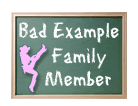Just some fun background information. Neural Basis of 'Number Sense' in Young Infants from Science Daily (2008)
A group of videos from Brannon Lab - there are babies and animals.
I'm also including an earlier post of mine on counting which is more "scientific" than this one will be - Let's start with counting
So onto my musings. I started to wonder about what children might learn from counting. I'm not talking about learning their numbers or learning how to count "properly", but maybe some underlying things we don't normally think of.
(Jacqui's Disclaimer: Please keep in mind that this is personal opinion when I talk about counting or what we might learn from it. I'm relying on my memories (new and old) of children counting and have not done any research to back-up my ideas.)
Counting is first about putting things in order - defining a path with steps set out at regular intervals. Think about it. We learn to count by repeating the steps - one, two, three, and so on. As the numbers get bigger (somewhere above 10), children have a harder time getting the in between steps, but the general pattern remains. Think about it - children will quite often count to ten and then hit a few more numbers and go to twenty. The counting will go something like, "1, 2, 3, 4, 5, 6, 7, 8, 9, 10, 13, 17, 18, 20." Some steps are skipped but the order from smaller to larger is maintained.
So somewhere in counting, it appears that children either learn or have a built in understanding of counting as an orderly function from smallest to largest. As children get older, they learn other ways to count. The may count by two's or three's or, once fractions are learned, by halves usually. Order and regular intervals are maintained. Most children when counting by fractions seem to know to count as "1/2, 1, 1-1/2, 2, 2-1/2" and so forth. I can't remember hearing a child count by skipping around on the intervals with something like, "1/2, 1, 1-3/4, 2, 3" and so on unless they were purposely being silly.
Counting backwards also seems to maintain order and regular intervals although the path is reversed from largest to smallest.
So counting might teach children about order, about following a path, about assigning intervals between things. But what happens when numbers go from counting words with no particular concept tied to the individual numbers?
Once children learn to associate a concept with a number, what do they learn? At some point, children understand that a pile of 3 candies is smaller than a pile of 4 similar candies and can order piles of similar candies, but if the piles are made up of vastly different sized sweets (think a pile of 3 M&Ms and a pile of 2 chocolate chip cookies), the order might be decided based on the overall size of the piles rather than the number of items. But children do learn to discriminate between the two and to grasp an understanding of quantity.
Then somewhere in there they learn the concept of number. That is that two has a special meaning - its "twoness" that doesn't change whether you talking about two elephants or two pennies. This is an import thing to learn because the child has learned to think symbolically and communication is largely symbolic.
But all of this is a result of counting.
